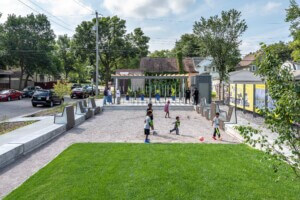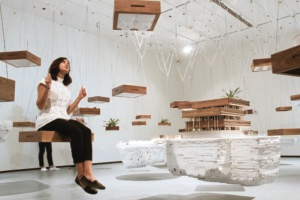This article is part of our series of profiles on The Architectural League of New York’s 2023 Emerging Voices winners published in the March/April issue of AN. The full list of winners can be found here.
Besides working as the founding principal of design firm All of the Above, Janette Kim codirects Urban Works Agency, a research laboratory at the California College of the Arts, where she is also an assistant professor in the school’s architecture program. Trained as an architect, Kim has interpreted “practicing” architecture as an action that includes advocacy, in addition to traditional design methods. This is reflected through her range of work, which includes both a proposal for the Resilient by Design Challenge, a collaborative design challenge that sought to address flood risks in the Bay Area, and Pengzhou Longmen Mountain Suji, a hotel in Sichuan, China.
Kim’s independent and academic practices weave common threads of interests in political ecology through an understanding of architecture focused on questioning power relationships within the built environment. Kim told AN that “I never saw my goal, or purpose, as creating buildings only.” She said that while “political ecology” as a term can feel quite academic, “the more architects acknowledge the complexity of practice, the more political ecology is inevitable.” To seriously address concerns about major crises like sea-level rise or wildfires, Kim said, you have to address questions of “who can afford to rebuild, who can afford to stay… [and then you arrive] at political ecology.”

While the questions that motivate Kim address overarching structural issues, they manifest in specific ways in individual projects. Speaking about the hotel in Sichuan, which is currently under construction, Kim said that “the project was motivated by the site, program, and client. But in other ways, it was for us a chance to say, ‘Well, if people are going to go to this landscape to enjoy it, we should talk about what it means to, first of all, be a tourist in a landscape. What’s the responsibility of a tourist?’”
Questions of spatial ownership, long-term maintenance, and decision-making have continually influenced her practice’s approaches. Considering “people who have historic rights to land” in addition to current owners, and a given space’s occupants, further shapes her approaches to design and advocacy. Noting the often-contested status of decisions on land use, particularly in response to immediate concerns about climate change, Kim retains an optimism surrounding the challenges of working with stakeholders with whom she disagrees. In summarizing her approach, she prizes the value of conversation: “I’m very committed to the idea of bringing all those people to the table and allowing debate to happen. We leave out opportunities to have influence if we don’t engage them.”











